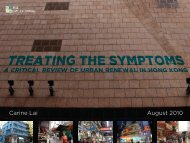Untitled - Civic Exchange
Untitled - Civic Exchange
Untitled - Civic Exchange
Create successful ePaper yourself
Turn your PDF publications into a flip-book with our unique Google optimized e-Paper software.
SUSTAINABLE TRANSPORT IN HONG KONG: DIRECTIONS AND OPPORTUNITIES<br />
the doubling of the fleet in less than two decades. 213<br />
The projection regarding cross-border goods traffic by road may be even more extraordinary in view of<br />
recent trends. The composition of the cross-border traffic is not addressed in the report, except by a<br />
suggestion that it will reflect historical trends. If this were to be the case, the preferred projection would<br />
imply a total of close to 93,600 daily goods vehicle crossings in 2016, nearly a fourfold increase over the<br />
actual number of crossings in 2001. The actual increase since 1995 seems to have been about 14% (see<br />
Figure 6.3). Thus - again for reasons that are not explained - a period of modest growth in cross-border<br />
goods traffic (2.2% a year) is to be followed by 15 years of astonishing growth (9.2% a year). 214<br />
The factors underlying government projections of the goods vehicle fleet and of cross-border trips by goods<br />
vehicles may be the same as those mentioned earlier as responsible for the equally extraordinary<br />
projections in seaborne freight, namely wishful thinking and lack of realistic appraisal of trends and<br />
opportunities. It could be argued that economic circumstances made the late 1990s and even all of the<br />
1990s unusual, and this period is thus a poor basis for forecasting the next two decades. While this may be<br />
so, this argument was not presented in the forecast documents. Moreover, the almost uninterrupted growth<br />
in airfreight handled at Hong Kong's airports suggests that the effects of economic circumstances on freight<br />
movement were not pervasive.<br />
Finally, the absence of current projections regarding rail freight should be noted. Presently, almost no<br />
freight is moved by rail in Hong Kong. The last review of freight transport 215 recommended construction<br />
of a Port Rail Line (PRL) by 2003, estimating that it would increase the total tonnage of cross-border<br />
freight by 10% and also reduce the amount carried by road by about 15%. The line would link the Kwai<br />
Chung container terminal with the rail network in mainland China.<br />
A PRL was proposed again in 2000 without predictions as to its effect, but with the puzzling note that its<br />
implementation "hinges on growth of the rail-borne freight to the Kwai Chung ports." The document also<br />
noted that "the PRL would support the growth of the port cargo by tapping freight from the deep hinterland<br />
of the Mainland and could benefit the SAR's economy." 216 The current status of the project appears to be<br />
that the government is committed to construction of the PRL but that detailed design work has yet to<br />
begin. 217<br />
6.3 Hong Kong as a logistics hub for south China<br />
Uncertainties about Hong Kong's future as an entrepot for mainland China prompted the Port and Maritime<br />
Board to establish a Committee on Logistics Services Development in 2000 and to commission what<br />
became known as the McClier Report. 218 This HK$40 million report was produced in 2001 by a consulting<br />
team headed by the McClier Corporation, a Chicago-based firm of architects and engineers. It proposed a<br />
"Competitive Strategy and Master Plan for Hong Kong as the Preferred International Regional<br />
64<br />
213 This ambitious projection echoes the projection of growth in the goods vehicle fleet made in the early 1990s.<br />
Then, a 25% increase was projected between 1991 and 2001, but no growth occurred (see Footnote 197).<br />
214 This truly extraordinary projection echoes similar projections about cross-border goods vehicle crossings made<br />
in the early 1990s. Then, a 135% increase in border crossings was projected between 1991 and 2001, more than<br />
twice the increase that actually occurred (see Footnote 197).<br />
215 Transport Department (1994), Freight Transport Study.<br />
216 Transport Bureau (2000), Second Rail Development Strategy, Hong Kong: HKSAR Government.<br />
217 This was indicated in a response by the Secretary for Transport to a question posed in the Legislative Council<br />
(January 9, 2002). The PRL was also promoted in the McClier Report as part of a proposal for an "Inland Logistics<br />
Rail Pipeline" (see section 6.3).<br />
218 PMB (2001), Study to Strengthen Hong Kong's Role as the Preferred International and Regional Transport and<br />
Logistics Hub, Hong Kong.

















